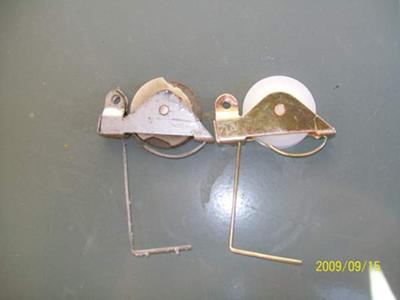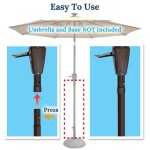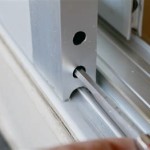How To Replace the Rollers On A Sliding Patio Screen Door
Sliding patio screen doors provide ventilation and natural light while keeping insects out. Over time, however, the rollers that allow the door to glide smoothly along its track can wear down, causing the door to stick, drag, or even become impossible to open and close. Replacing these rollers is a relatively straightforward repair that can significantly improve the function and usability of the door. This article provides a comprehensive guide on how to replace the rollers on a sliding patio screen door, covering the necessary tools, the removal process, the selection of appropriate replacements, and the installation procedure.
Identifying Worn Rollers and Determining the Need for Replacement
The primary indicator of worn rollers is difficulty in operating the sliding screen door. Specific signs to watch for include:
- Sticking or dragging: The door requires excessive force to move along the track.
- Uneven movement: The door moves smoothly in some sections of the track but sticks in others.
- Noise: Grinding, scraping, or squealing sounds emanate from the rollers during operation.
- Visible damage: Examination of the rollers reveals cracks, chips, flat spots, or excessive wear on their surfaces.
Before assuming the rollers are the problem, it's important to rule out other potential causes of door malfunction. Check the track for debris, such as dirt, leaves, or small objects, which can obstruct the rollers' movement. A thorough cleaning of the track may resolve the issue without requiring roller replacement. Also, check the alignment of the door within the frame. A misaligned door can put undue stress on the rollers, causing them to wear prematurely. If cleaning the track and aligning the door do not alleviate the problem, roller replacement is likely necessary.
A visual inspection of the rollers is crucial. To inspect the rollers, the door needs to be partially or completely removed from the track. Look for physical damage such as cracks, chips, or flat spots on the rolling surface. Even if the damage is not immediately apparent, test the rollers by spinning them. If they do not spin freely or if they wobble, they are likely worn and should be replaced. Consider replacing all the rollers on the door at the same time, even if only one or two appear to be significantly damaged. This ensures consistent performance and avoids having to repeat the repair process in the near future.
Gathering Necessary Tools and Materials
Having the correct tools and materials on hand before starting the repair will streamline the process and minimize potential frustration. The following items are typically required for roller replacement:
- New Rollers: Identical or compatible replacement rollers are essential.
- Screwdrivers: A Phillips head and a flathead screwdriver are usually needed.
- Putty Knife or Flat Pry Bar: For gently removing the door and adjusting the roller assemblies.
- Measuring Tape: To measure the roller housing and wheel diameter for accurate replacement purchasing.
- Pliers: For gripping and manipulating small parts, if necessary.
- Cleaning Supplies: A brush and cleaning solution to clean the track and surrounding areas.
- Lubricant: Silicone-based lubricant to improve roller performance after installation.
- Safety Glasses: To protect eyes from debris.
- Work Gloves: To protect hands and improve grip.
Selecting the correct replacement rollers is a critical step. There are numerous types and sizes of rollers available, so it's important to choose rollers that are compatible with the existing door and track. Ideally, remove one of the old rollers and take it to a hardware store for matching. Alternatively, carefully measure the diameter of the roller wheel, the width and height of the roller housing, and the overall length of the assembly. Also, note the type of mounting mechanism, such as a single screw, two screws, or a clip. Ordering rollers online can be done with the measurements, but take extra care in verifying the product details and compatibility with the door.
Step-by-Step Guide to Replacing the Rollers
The roller replacement process involves removing the door, accessing the rollers, removing the old rollers, installing the new rollers, and reinstalling the door. The following steps detail the process:
- Removing the Door: Most sliding screen doors can be lifted slightly to disengage them from the bottom track. Locate the adjustment screws, usually found at the bottom corners of the door frame, and loosen them slightly to lower the rollers as far as possible. This provides more clearance for lifting the door. Using a putty knife or flat pry bar, gently pry the door upwards, starting at one corner. Work slowly and evenly to avoid bending or damaging the door frame. Once the door is clear of the bottom track, carefully pull it out from the top track. If the door is particularly heavy, enlist assistance to prevent injury. Once removed, lay the door flat on a protected surface, such as a drop cloth or cardboard, to prevent scratches or damage.
- Accessing the Rollers: The rollers are usually located within housings at the bottom corners of the door. These housings are typically held in place by screws or clips. Locate the screws and use a screwdriver to remove them. If clips are used, carefully pry them off with a flathead screwdriver or putty knife. Once the housings are detached, the rollers will be accessible. Note the orientation of the roller assemblies for ease of reinstallation.
- Removing the Old Rollers: The old rollers may be held in place by a screw or simply slide out of the housing. Remove any screws securing the rollers. If the rollers are stuck, use pliers to gently grip and pull them out. If they are heavily corroded or damaged, applying penetrating oil may help to loosen them. Be careful not to damage the roller housing during the removal process.
- Installing the New Rollers: Insert the new rollers into the roller housings, ensuring they are oriented correctly. Secure them with the screws, if applicable. Make sure the rollers spin freely within the housings. If the rollers are adjustable, set them to their lowest position to provide maximum clearance for reinstalling the door.
- Reinstalling the Door: Carefully lift the door and align it with the top track. Slide the top of the door into the track first, then lower the bottom of the door onto the bottom track. Ensure the rollers are properly seated in the track. If necessary, use the putty knife or flat pry bar to gently guide the door into place.
- Adjusting the Rollers: Once the door is reinstalled, adjust the roller height using the adjustment screws at the bottom corners of the door. Turn the screws clockwise to raise the door and counterclockwise to lower it. Adjust the rollers until the door glides smoothly and evenly along the track. The door should not rub against the frame or the track.
- Testing and Lubricating: Open and close the door several times to test its operation. If the door sticks or drags, readjust the rollers as needed. Once the door is operating smoothly, apply a small amount of silicone-based lubricant to the rollers and the track. This will further improve the door's performance and extend the life of the rollers.
Following these steps will facilitate a successful roller replacement, restoring the smooth operation of the sliding patio screen door.
Troubleshooting Common Problems
Despite following the steps outlined above, some problems might surface during or after the roller replacement process. These problems can be addressed with careful observation and problem-solving skills.
- Door Still Sticks After Roller Replacement: If the door continues to stick even after installing new rollers, the problem may lie elsewhere. Double-check the track for debris or damage. A bent or damaged track can impede the rollers' movement regardless of their condition. Thoroughly clean the track and consider using a track repair kit if necessary. Also, re-examine the door's alignment. A misaligned door can put uneven pressure on the rollers, causing them to bind. Adjust the door within the frame to ensure it is square and level. If the new rollers are not the correct size or type, they may not fit properly in the track or the roller housings. Verify that the replacement rollers are compatible with the existing door and track.
- Difficulty Adjusting Roller Height: Sometimes, the adjustment screws can become stripped or corroded, making it difficult to adjust the roller height. If the screws are stripped, they may need to be replaced. Penetrating oil can help to loosen corroded screws. If the adjustment mechanism is damaged, the entire roller housing may need to be replaced.
- Door is Difficult to Lift Into the Top Track: If the door is difficult to lift into the top track, it may be necessary to loosen the rollers as much as possible before attempting to reinstall the door. This will provide maximum clearance. If the door is particularly heavy, enlist the help of another person to avoid injury. Make sure the top track is clean and free of obstructions.
- New Rollers Squeak: A squeaking sound after installing new rollers usually indicates a lack of lubrication. Apply a small amount of silicone-based lubricant to the rollers and the track. This should eliminate the squeaking and improve the door's performance.
By systematically addressing these potential problems, the roller replacement process can be successfully completed, resulting in a smoothly operating sliding patio screen door. If these steps do not resolve the issue, it might be best to seek the assistance of a professional door repair service.

Replacing A Sliding Screen Door Roller

How To Replace Screen Door Rollers

Sliding Screen Door Repair Tips Diy Family Handyman

Screen Door Rollers Getting Them Removed

How To Replace A Sliding Screen Door Roller 1080p

Sliding Door Repair Track Glass Roller Weatherstrip

Replacing Patio Door Rollers Like A Pro Quick And Easy Tutorial

Replacing Patio Door Rollers Like A Pro Quick And Easy Tutorial

Screen Door Rollers Getting Them Removed

The Right Roller For Your Patio Screen Door Pca S








